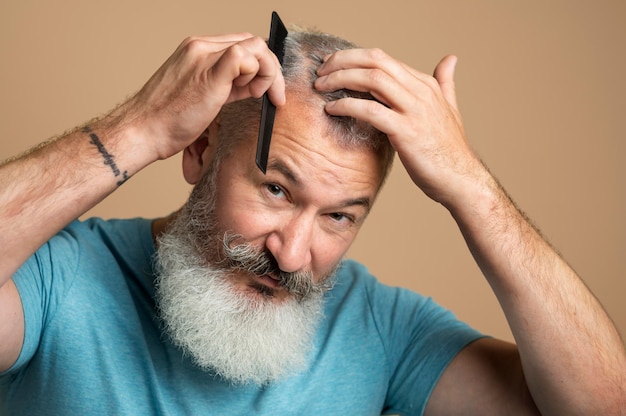
Spotting the first signs of hair loss can be unsettling, no matter if you’re in your 20s or 60s. But before diving into panic mode and inspecting every hair in the shower, it’s important to understand what’s really happening. Hair loss can stem from several causes, and it’s not always inevitable.
### The Most Common Culprit: Male Pattern Baldness (Androgenetic Alopecia)
For 95% of men experiencing hair loss, the main reason is androgenetic alopecia, also known as male pattern baldness. This condition is influenced by genetics and hormones, making it hereditary, and it becomes more noticeable as you age. To put it in perspective:
– About 25% of men with this condition start seeing hair loss by age 21.
– By age 35, over 60% of American men experience visible hair thinning.
– By age 50, significant thinning affects around 85% of men.
Hair grows in cycles, but for those with male pattern baldness, the cycle gradually weakens. Over time, hair follicles get smaller, making hair strands thinner until the follicles stop producing hair entirely. Usually, hair starts thinning at the temples and later on the crown of the head. Eventually, this pattern can result in the classic horseshoe-shaped hairline.
### Other Possible Causes
While male pattern baldness is the primary cause, other less common factors can also contribute to hair loss. Acting early can sometimes help slow or even prevent further thinning in these cases.
**Hair Damage from Styling:** Overusing hair dyes, heat styling tools, or applying harsh products can damage hair, causing it to break and fall out.
**Alopecia Areata:** This autoimmune disorder leads to patchy hair loss on the scalp or other body areas. It often appears as small, round bald spots on the head.
**Vitamin Deficiencies:** If your diet is lacking essential nutrients like vitamin B, vitamin D, or zinc, your hair follicles could suffer. Eating a balanced diet or adding a multivitamin can help maintain healthy hair.
**Stress:** Ever feel like stress is making you want to tear your hair out? It turns out, severe stress can take a toll on your body, including your hair. When dealing with ongoing physical or emotional stress, your body might prioritize essential processes over hair growth.
**Medications and Treatments:** Some medical treatments, such as chemotherapy, are well-known causes of hair loss. If your hair starts thinning after starting a new medication, it’s worth bringing this up with your doctor.
### Treatments for Male Pattern Baldness
When it comes to treating male pattern baldness, timing is crucial. Restoring lost hair becomes more challenging as the condition progresses, but there are options that can help slow down or even reverse some of the effects.
Popular medications include **finasteride (Propecia)** and **minoxidil (Rogaine)**. These can either be applied topically or taken orally to help preserve existing hair follicles and occasionally revive dormant ones.
**Low-level laser therapy (LLLT)** has also shown promise in encouraging hair growth. Other remedies like ketoconazole shampoo, pumpkin seed oil, and rosemary oil can complement treatments as well.
If these methods don’t quite do the trick, more advanced cosmetic and medical procedures are available. Toupees and wigs, for instance, have improved significantly in quality and appearance, helping to reduce the stigma around them. Meanwhile, surgical options, such as **platelet-rich plasma injections** or **hair transplants**, offer more permanent solutions.
The key is to find an approach that works best for your situation. Consulting with a doctor can help you pinpoint the underlying cause of your hair loss and explore the full range of treatment possibilities.